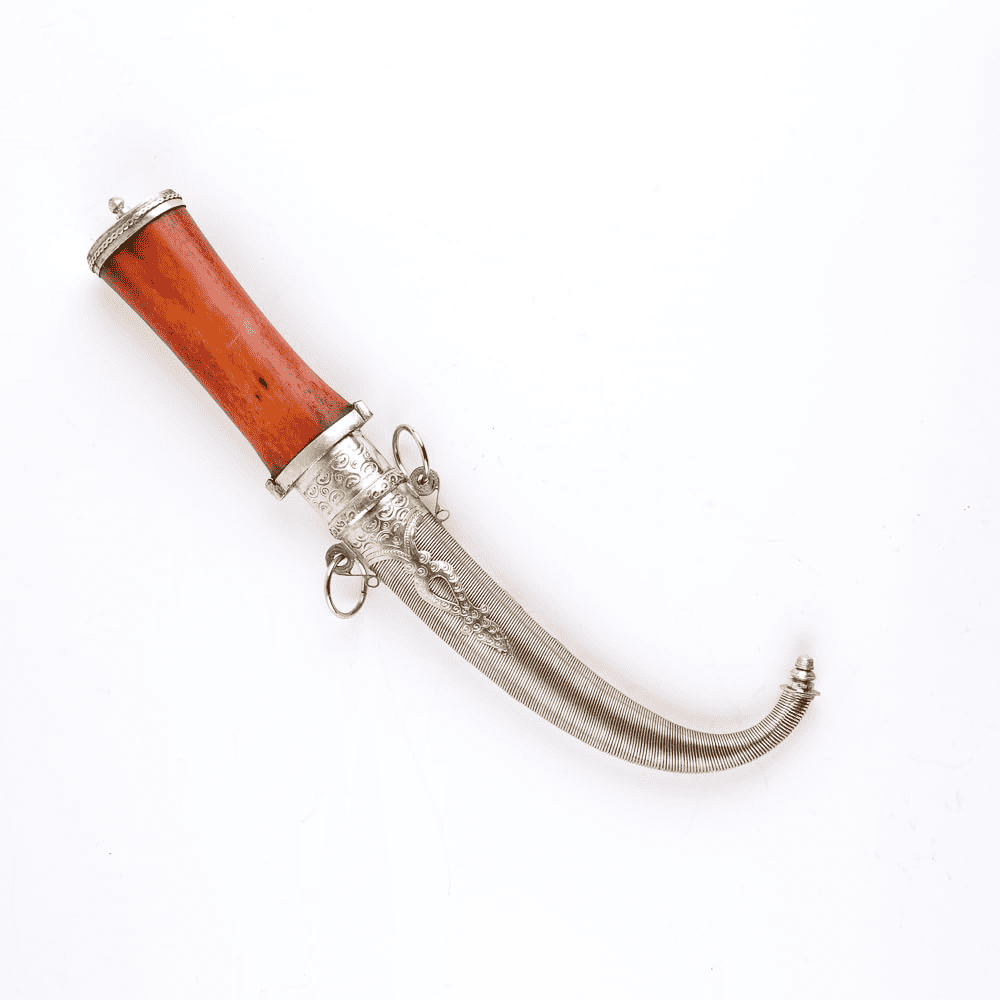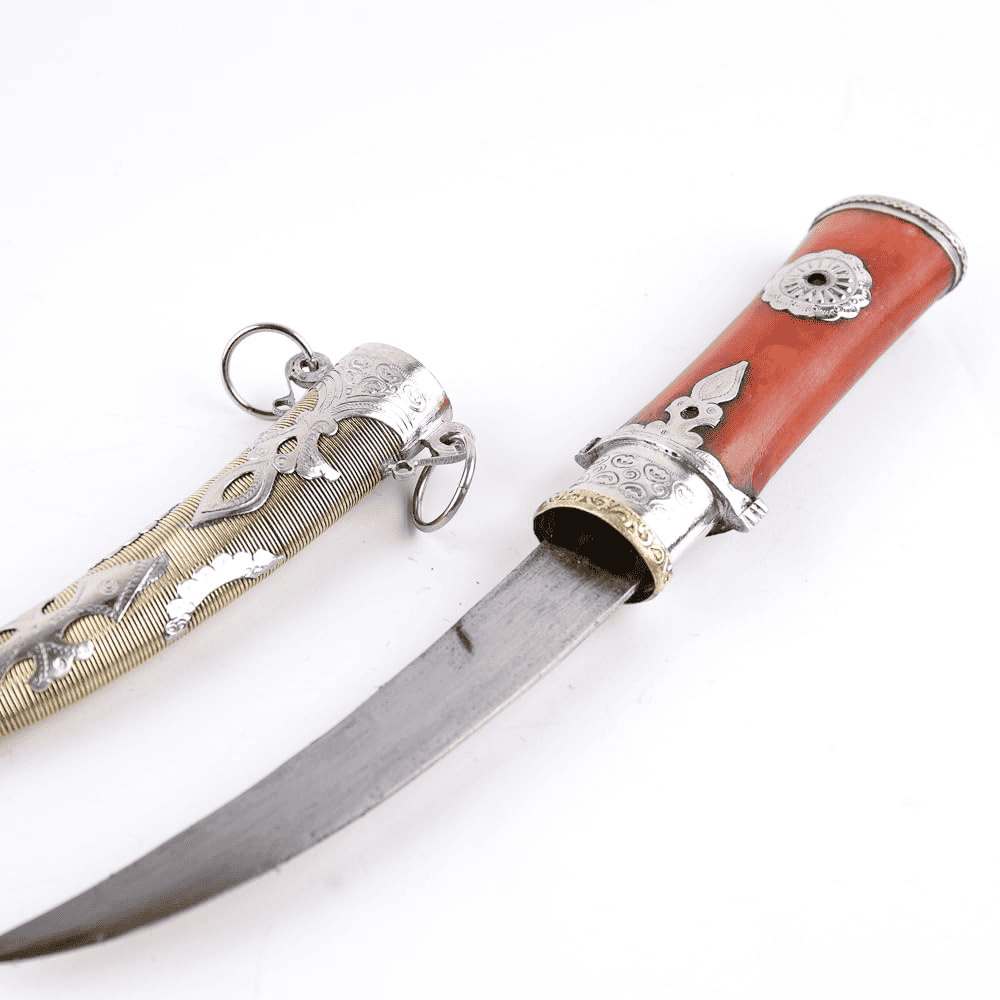What Makes the Moroccan Khanjar Knife Distinct from Other Daggers?
The Moroccan Khanjar, also referred to as the Koummya or Koumaya, stands apart due to its distinctive curved blade, ornate detailing, and strong cultural significance. Unlike mass-produced items, this traditional Berber dagger carries historical relevance and serves more as a symbol of heritage than as a weapon. Originating from the Berber regions of Morocco, the Khanjar’s silhouette mimics that of the Arabic Jambiya, a broader category of curved daggers. It is shaped with an upward curve, tapering to a pointed end, and a decorated handle and sheath that reflect centuries of artisanal craftsmanship. Each dagger is individually made, carrying imperfections that reflect its handmade origin, not flaws. These irregularities make each piece unique.
- Traditional Koummya design linked to Berber identity
- Recognizable curved blade style for visual appeal
- Unique imperfections from handcrafting
- Symbolic cultural item, not mass-produced
How Does the Blade’s Material Influence Function and Display?
The blade of this Moroccan dagger is crafted from stainless steel, chosen for its resistance to rust and ability to hold its shape over time. Though primarily intended as a decorative piece, the blade’s solid construction gives it a tactile sense of weight and authenticity. It can be polished for shine or left as-is to emphasize its vintage appeal. Minor rusting may be present, but this adds to its antique aesthetic. Unlike display items made from softer metals, the stainless steel composition provides longevity for collectors, especially when maintained with basic care. Its decorative nature doesn’t compromise its strength.
- Blade made of durable stainless steel
- Capable of long-term display without corrosion
- Can be polished or kept vintage
- Minor rust contributes to the aged aesthetic
What Role Does the Handle and Sheath Design Play in the Knife’s Appearance?
The handle and sheath of the Khanjar knife contribute as much to its identity as the blade itself. Crafted from materials like bone and decorated in traditional Moroccan motifs, these parts showcase intricate handiwork. The sheath features twin bail rings, allowing the dagger to be suspended at the waist in traditional fashion. Its decorative carvings, color tones, and natural imperfections reflect a raw, artisanal charm. These components turn the dagger into a decorative centerpiece, suitable for shelves, display cases, or wall mounts.
- Hand-decorated bone and sheath construction
- Twin bail rings for traditional mounting
- Carvings add visual depth and authenticity
- Imperfections enhance handmade appeal
How Does the Knife’s Size Suit Its Purpose as a Decorative Piece?
With dimensions of approximately 24 cm (9.45 inches) in length, this Khanjar fits comfortably as a display item without overwhelming a space. Its compact form allows it to be stored in curio cabinets, framed in shadow boxes, or placed on a small stand. The size is large enough to showcase the intricate detail yet small enough for practical indoor display. This moderate scale suits collectors looking for cultural artifacts that are visually engaging but not burdensome in space.
- Mid-sized at 24 cm (9.45 inches)
- Easy to fit on bookshelves or display stands
- Ideal size for wall-hung displays
- Compact but detailed
Why Are Handmade Imperfections Considered a Positive Feature?
Each Khanjar is made by hand using traditional techniques passed down through generations. This process introduces imperfections such as asymmetry, minor rust, or uneven carvings, which are considered signs of authenticity rather than flaws. Unlike factory-made replicas, a handmade dagger reflects the artisan’s hand at work. The irregularities are a testament to cultural preservation, not manufacturing faults. Buyers looking for a perfect, uniform piece should reconsider—this item is intended to reflect real craftsmanship.
- Handmade variations ensure uniqueness
- Irregularities seen as artistic marks, not defects
- Not machine-produced; traditional techniques used
- Appeals to buyers seeking originality
What Historical and Cultural Significance Does the Koummya Carry?
The Koummya has long served as more than a weapon in Moroccan culture. Worn ceremonially by Berber tribes, especially the Chleuh of the Atlas region, it symbolizes social rank, tribal identity, and male elegance. It is often worn on the left side, suspended from a cord running over the shoulder. This placement is more ritualistic than defensive. The dagger’s association with masculinity, honor, and cultural pride makes it a meaningful addition to heritage collections or ethnographic displays.
- Historically worn by Berber tribesmen
- Denotes status, elegance, and heritage
- Functional symbolism in traditional attire
- Ideal for cultural collections
How Can This Item Be Used as a Gift or Souvenir?
Because of its craftsmanship and cultural weight, the Moroccan Khanjar makes a thoughtful and personal gift. Whether presented as a souvenir, a collector’s item, or a home decor accent, its origin story enhances its value. The recipient receives not just an object, but a symbol of Morocco’s artisanal legacy. It suits gift-giving during cultural holidays, weddings, or milestones where heritage and individuality are celebrated.
- Suitable for heritage-focused gifting
- Ideal as a travel souvenir
- Carries deeper cultural meaning
- Appealing to collectors and historians
What Type of Collector or Enthusiast Would Value This Item?
Collectors of Middle Eastern or North African artifacts, antique weaponry, or handmade metalwork will find this piece significant. It aligns with interests in ethnography, traditional weapons, and cultural heritage. The dagger fits within categories such as Islamic antiques, tribal jewelry and tools, and ceremonial artifacts. Its authenticity, design, and material cater to a niche yet dedicated audience that values tradition and detail.
- Appeals to antique collectors
- Suited for ethnographic and Islamic art displays
- Matches traditional weaponry themes
- Valuable for hobbyists and cultural curators
How Should This Dagger Be Cared for and Maintained?
Though not intended for combat or use, the dagger benefits from simple care. Light polishing of the stainless steel blade with a soft cloth helps reduce visible rust or tarnish. The bone handle and sheath should be kept away from excess moisture and sunlight to avoid cracking or fading. When displayed, ensure it’s mounted securely to protect both the item and surrounding surfaces. With occasional attention, the item retains its appearance and remains a conversation piece.
- Wipe blade gently to maintain sheen
- Keep handle and sheath dry and shaded
- Mount securely for safe display
- Avoid harsh cleaning chemicals
How Does the Knife Fit into a Broader Home Decor Style?
In home decor, this dagger complements rustic, bohemian, or culturally-themed spaces. Whether placed on a mantle, mounted on a wall, or laid within a decorated tray, it adds a touch of old-world character. It works particularly well in Moroccan, Middle Eastern, or African-inspired interiors, where textures, history, and craftsmanship take center stage. The organic materials, rich colors, and weathered detailing bring warmth and storytelling to a room.
- Works with Moroccan or bohemian decor themes
- Adds cultural depth to interior settings
- Visual focal point in artful arrangements
- Enhances authenticity in global-themed interiors






Reviews
There are no reviews yet.